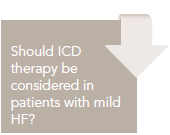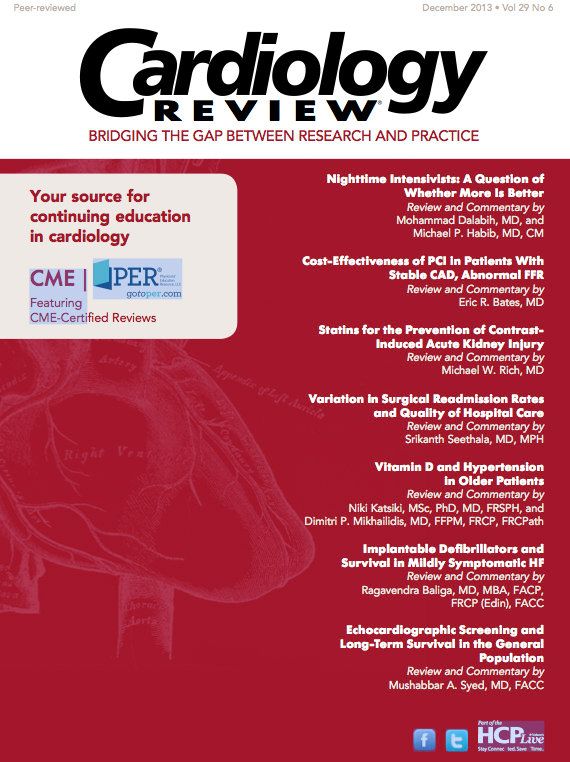Publication
Article
Cardiology Review® Online
Implantable Defibrillators and Survival in Mildly Symptomatic HF

Ragavendra Baliga, MD, MBA, FACP, FRCP (Edin), FACC
Review
Gold MR, Daubert JC, Abraham WT, et al. Implantable defibrillators improve survival in mildly symptomatic heart failure patients receiving cardiac resynchronization therapy: analysis of the long-term follow-up of REVERSE. Circ Arrhythm Electrophysiol. Published online Oct 14, 2013.

Cardiac resynchronization therapy (CRT) has been shown to improve functional status and reduce heart failure (HF) hospitalizations and mortality among HF patients with left ventricular (LV) systolic dysfunction and QRS prolongation. The benefits of CRT have been shown with both CRT pacemakers (CRT-P) and CRT with implantable defibrillators (CRT-D), but there are few studies comparing outcomes between CRT-P and CRT-D devices. The COMPANION study compared optimal medical therapy, CRT-P, or CRT-D, in advanced HF patients and was designed to compare outcomes between medical therapy and the groups receiving the devices. Other studies compared CRT-D versus implantable cardioverter defibrillators (ICDs). This study (REVERSE), by Gold et al, was designed to compare clinical outcomes and long-term survival among CRT patients with and without ICD.
REVERSE (REsynchronization reVErses Remodeling in Systolic left vEntricular dysfunction) was a multicenter trial that compared CRT-P in patients with mild systolic HF.1 Patients enrolled were NYHA class I or II HF with QRS duration ≥120 msec on EKG; left ventricular ejection fracture (LVEF) ≤0.40, and left ventricular end-diastolic dimension (LVEDD) ≥55 mm on transthoracic echocardiography (TTE). Gold et al2 report the findings of a preplanned 5-year follow-up of the patients enrolled in REVERSE. The study cohort comprised 419 patients randomized to CRT-ON (active CRT), 74 of whom received CRT-P devices, while the remaining 345 patients received defibrillator back-up (CRT-D). Patients in the CRT-OFF group (controls) were programmed ON after the randomization period and therefore were not included in this study. Long-term follow-up of the study cohort was preplanned for 5 years so that sustained benefit and cost-effectiveness of treatment could be analyzed.
All-cause mortality was low (<3% annually). The investigators found that CRT-P patients were less likely to have ischemic cardiomyopathy and more likely to have left bundle branch block morphology on their upaced ECG. Patients who received CRT-D had larger baseline LV end-systolic left ventricular size, a lower mean LVEF, and were more likely to have had right bundle branch block and intraventricular conduction disturbance.
Over a period of 2 years, inappropriate shock for non-VT/VF (ventricular tachycardia/ventricular fibrillation) episodes occurred in 8% of patients. Over the same period, 18.7% of the CRT-D patients had an appropriate shock. These shocks terminated 17.6% (n = 54) of the 307 VT/VF episodes whereas anti-tachycardia pacing terminated the remaining 253 episodes. Complications related to the device and/or device implantation occurred in 28% of 74 CRT-P (n = 25 complications) and 34% of the 345 CRT-D group patients (n = 191 complications). During the 5-year follow-up period, complications related to the RV lead were higher in the CRT-D group (18.3%; 76 complications in 63 of 355 patients) compared with the CRT group (6.8%; 5 complications in 5 of 74 patients). In the CRT-D group a majority of these complications were related to the Fidelis lead, which has since been withdrawn from the market.
The authors report that there was improved survival in the CRTD group (65% reduction in mortality; hazard ratio [HR], 0.35; P = .003), whereas there was only a 24% risk reduction in the CRT-P arm (P = .59; borderline significant). Other indices such as quality of life, 6-minute walk duration, clinical composite scores, and LV end-systolic volume index were similar in both groups. The mortality benefit with CRT was more likely in younger patients, women, increased unpaced QRS duration, and smaller LV volumes. Although the multivariate analysis demonstrated that CRT-D is more likely to improve survival given the study design and sample size, it did not reach statistical significance.
CommentaryProof of Cost- Effectiveness Is Needed
The results of this study, suggesting CRT-P is more effective in improving survival than CRT-D, support the thesis that mortality in NYHA class I or II systolic HF is more likely to be due to sudden death. An earlier trial3 comparing CRT-D with ICD reported that mild systolic HF patients (LVEF ≤30% and NYHA class I or II symptoms) and wide QRS intervals (≥130 msec) benefited with CRT-D compared with an ICD alone; however, there was no mortality benefit. These patients had improved ventricular function and reduced the risk of worsening HF; these effects were most pronounced when the QRS interval was ≥150 msec. CRT did not reduce death in this population with a relatively low mortality, which could be explained by the findings of MERIT-HF3, that in milder forms of HF there was less pump dysfunction and consequently less dyssynchrony, making CRT less effective.
Ventricular arrhythmias are responsible for about half the mortality that occurs in systolic HF; this proportion is higher in those with mild symptoms, whereas the more likely cause is pump failure4 (in the MERIT-HF4 study sudden death was the cause of mortality in 64%, 59%, and 33% of NYHA class II, III, and IV patients, respectively, whereas poor pump function was the cause of mortality in 12%, 26%, and 56% in NYHA class II, III, and IV, respectively). An ICD improves survival in systolic dysfunction5 with very little adverse effect on the quality of life,6 although the benefit is apparent only a year or more after implantation of the ICD.5 The SCDHeFT trial reported that ICD therapy improved survival in NYHA class II but not class III patients. ICDs are utilized for secondary prevention in those patients who survive an unprovoked episode of VF or sustained VT, and in primary prevention in patients with systolic HF, NYHA functional class II or III, despite optimal medical therapy, and who are expected to survive at least a year with reasonable quality of life. One study has suggested that ICD implantation is likely to be futile when HF is simply too advanced.7 In fact, in their critique of the ICD literature, Tung et al8 disputed the effectiveness of ICDs compared with anti-arrhythmic drugs. In their opinion, there was (a) inadequate beta-blocker utilization in the control arm of most studies, (b) underestimation of the effects on morbidity, quality of life, and potential for proarrhythmia because appropriate ICD shocks are not necessarily equal to life-saving shocks, (c) a propensity for device and lead malfunction, and (d) incomplete analyses of the cost-effectiveness of device therapy because hospitalizations, recurrent shocks, and lead replacement are not factored in adequately.
About one-third of the patients with severe systolic HF have a QRS duration ≥120 msec, a marker of impaired ventricular emptying and, occasionally, mitral regurgitation due to dyssynchronous contraction of the left ventricle. CRT with atrial-synchronized pacing usually improves cardiac performance by increasing stroke volume and reducing mitral regurgitation. CRT was first reported in 1994,8 and the MIRACL study was the first to report clinical benefit in moderate to severe HF,9 which included improvements in distance walked in 6 minutes, NYHA functional class, quality of life, time on the treadmill during exercise testing, and ejection fraction. Subsequently, mortality benefit was also reported in moderate to severe HF.10,11 The benefit of resynchronization therapy has been reported in mild to moderate systolic HF.1,3,12 Consequently, current white papers and guidelines13-15 recommend that CRT be considered in systolic HF patients in sinus rhythm and a wide QRS complex (>120 msec) with symptoms that persist despite optimal medical therapy. Clinical benefit appears to be greatest in those with the most prolonged QRS duration and left bundle-branch block.
There are limitations associated with implanting devices in mild HF, including (a) the difficulty of implanting the LV lead successfully because of varying coronary venous anatomy, (b) discomfort due to diaphragmatic stimulation because of proximity to the left phrenic nerve, (c) lead dislodgement, which can occur in as many as 10% of patients in whom the implantation is initially successful,16 (d) coronary sinus dissection, (e) cardiac perforation, (f) LV dysfunction worsened by inadvertent right ventricular pacing, and (g) inappropriate ICD shocks.17 These limitations must be kept in mind before considering device therapy in mild HF.
As Gold et al discuss, this study was not designed to evaluate the role of ICD therapy in NYHA class I therapy. However, this study supports the findings that ICD therapy should be considered in patients with mild HF.5 Proof of cost-effectiveness is urgently required before CRT-D is offered to all patients with mild HF. The routine utilization of device therapy in HF has also been questioned,18 prompting calls for studies to better predict mortality in systolic heart failure.19 Given that sudden death is more likely to occur in milder forms of HF, ICDs are more likely to be the treatment of choice in these patients, whereas CRT-D is more likely to be the device of choice in advanced forms of HF. However, pharmacologic therapy continues to change in the natural history of HF, and therefore ongoing studies of the natural history of HF are important in our efforts to provide appropriate therapy.
References
1. Linde C, Abraham WT, Gold MR, St John Sutton M, Ghio S, Daubert C. Randomized trial of cardiac resynchronization in mildly symptomatic heart failure patients and in asymptomatic patients with left ventricular dysfunction and previous heart failure symptoms. J Am Coll Cardiol. 2008;52: 1834-1843.
2. Gold MR, Daubert JC, Abraham WT, et al. Implantable defibrillators improve survival in mildly symptomatic heart failure patients receiving cardiac resynchronization therapy: Analysis of the long-term follow-up of reverse. Circulation. Arrhythmia and electrophysiology. 2013.
3. Moss AJ, Hall WJ, Cannom DS, et al. Cardiac-resynchronization therapy for the prevention of heart-failure events. N Engl J Med. 2009;361:1329- 1338.
4. Effect of metoprolol cr/xl in chronic heart failure: Metoprolol cr/xl randomised intervention trial in congestive heart failure (merit-hf). Lancet. 1999;353:2001-2007.
5. Bardy GH, Lee KL, Mark DB, et al. Amiodarone or an implantable cardioverter- defibrillator for congestive heart failure. N Engl J Med. 2005;352: 225-237.
6. Mark DB, Anstrom KJ, Sun JL, et al. Quality of life with defibrillator therapy or amiodarone in heart failure. N Engl J Med. 2008;359:999- 1008.
7. Levy WC, Lee KL, Hellkamp AS, et al. Maximizing survival benefit with primary prevention implantable cardioverter-defibrillator therapy in a heart failure population. Circulation. 2009;120:835-842.
8. Cazeau S, Ritter P, Bakdach S, et al. Four chamber pacing in dilated cardiomyopathy. PACE. 1994;17:1974-1979.
9. Abraham WT, Fisher WG, Smith AL, et al. Cardiac resynchronization in chronic heart failure. N Engl J Med. 2002;346:1845-1853.
10. Bristow MR, Saxon LA, Boehmer J, et al. Cardiac-resynchronization therapy with or without an implantable defibrillator in advanced chronic heart failure. N Engl J Med. 2004;350:2140-2150.
11. Cleland JG, Daubert JC, Erdmann E, et al. The effect of cardiac resynchronization on morbidity and mortality in heart failure. N Engl J Med. 2005;352:1539-1549.
12. Tang AS, Wells GA, Talajic M, et al. Cardiac-resynchronization therapy for mild-to-moderate heart failure. N Engl J Med. 2010;363:2385-2395.
13. McMurray JJ, Adamopoulos S, Anker SD, et al. Esc guidelines for the diagnosis and treatment of acute and chronic heart failure 2012: The task force for the diagnosis and treatment of acute and chronic heart failure 2012 of the european society of cardiology. Developed in collaboration with the heart failure association (hfa) of the esc. Eur Heart J. 2012;33: 1787-1847.
14. Yancy CW, Jessup M, Bozkurt B, et al. 2013 accf/aha guideline for the management of heart failure: A report of the american college of cardiology foundation/american heart association task force on practice guidelines. J Am Coll Cardiol. 2013;62:e147-239.
15. Baliga RR, Dec GW, Narula J. Practice guidelines for the diagnosis and management of systolic heart failure in low- and middle-income countries. Global Heart. 2013;8:141-170.
16. McAlister FA, Ezekowitz JA, Wiebe N, et al. Systematic review: Cardiac resynchronization in patients with symptomatic heart failure. Annals of Internal Medicine. 2004;141:381-390.
17. Moss AJ, Schuger C, Beck CA, et al. Reduction in inappropriate therapy and mortality through icd programming. N Engl J Med. 2012;367:2275- 2283.
18. Tung R, Zimetbaum P, Josephson ME. A critical appraisal of implantable cardioverter-defibrillator therapy for the prevention of sudden cardiac death. J Am Coll Cardiol. 2008;52:1111-1121.
19. Baliga RR, Young JB. Sudden death in heart failure: An ounce of prediction is worth a pound of prevention (editorial). Heart failure clinics. 2011;7:xiii-xviii.
About the Author
Ragavendra Baliga, MD, MBA, FACP, FRCP (Edin), FACC, is Chief Mentor Officer for Clinical Faculty and Associate Chief, Division of Cardiovascular Medicine, Wexner Medical Center, and Professor of Internal Medicine at The Ohio State University in Columbus. He received his MD from St. John’s Medical College in Bangalore, India, and completed his internal medicine residency at Victoria Hospital in Bangalore. He completed his cardiology fellowship at Hammersmith Hospital, London, UK, and advanced fellowships at Brigham & Women’s Hospital/Harvard Medical School, Boston University Medical Center, and UT Southwestern Medical Center, Dallas, TX. He is board-certified in internal medicine and cardiovascular diseases. Dr. Baliga was a faculty cardiologist at the University of Michigan and received an MBA from the Stephen Ross School of Business. He joined The Ohio State University in 2005.






